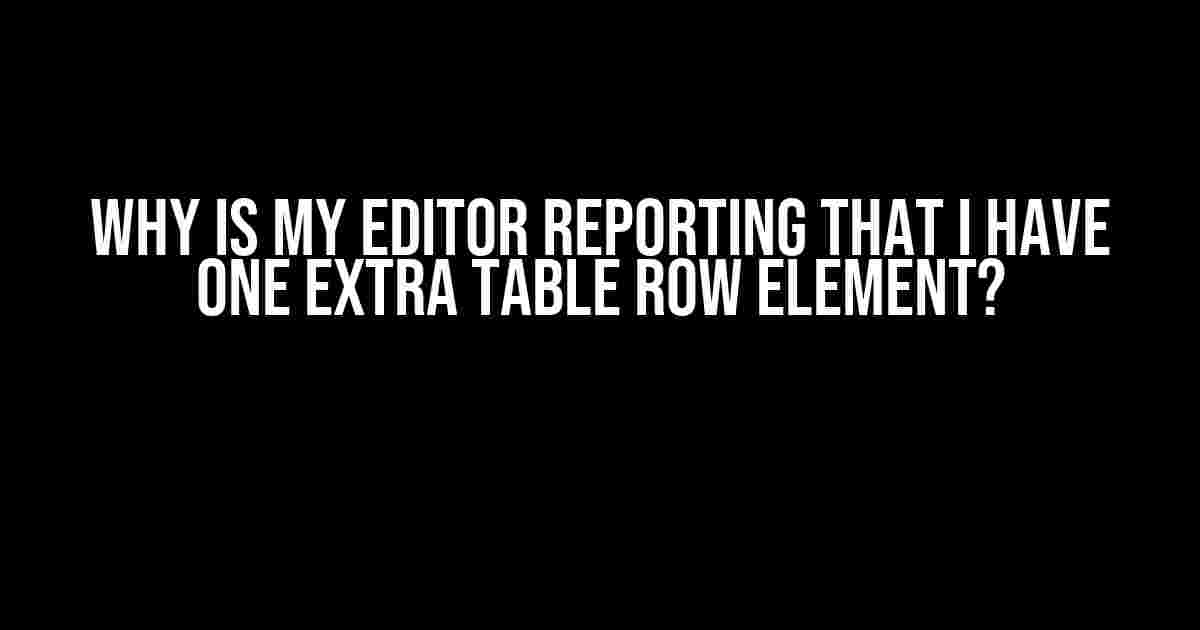Have you ever been in the middle of coding away, feeling like a boss, when suddenly your editor throws a curveball at you? You know, that annoying warning that just won’t go away: “You have one extra table row element.” Ugh, the frustration is real! But fear not, dear coder, for we’re about to dive into the world of table row elements and figure out what’s going on.
The Mystery of the Extra Table Row Element
A table row element, denoted by the `
Possible Causes of the Error
Before we dive into solutions, let’s explore some possible causes of this error. Take a look at the following scenarios:
- Mismatched or Missing Closing Tags: A common culprit behind the “extra table row element” error is a mismatch between opening and closing tags. Check if you’ve got an unclosed `
` tag somewhere in your code. - Incorrect Nesting: Make sure your table elements are properly nested. A `
` element should always be a direct child of a ` ` or ` ` element. If you’ve got a `
` element inside another ` ` or ` `, that’s a recipe for disaster! - Duplicate Table Row Elements: Yep, you guessed it – having duplicate `
` elements can also trigger this error. Be cautious when copying and pasting code to avoid duplication. - Table Row Elements Outside of a Table: This one’s a no-brainer, but it’s easy to overlook. Ensure that your `
` elements are always contained within a ` ` element.
Inspecting Your Code
Now that we’ve covered the possible causes, let’s take a closer look at your code. Follow these steps to identify the issue:
View Source Code: Open your HTML file in a code editor or IDE and view the source code. Yes, we’re going old-school here!Use the Developer Tools: If you’re using a modern browser, press F12 or right-click on the page and select “Inspect” or “Inspect Element.” This will open the Developer Tools. Switch to the “Elements” tab.Search for the Offending Element: Use the search function (Ctrl + F on Windows or Cmd + F on Mac) to find the `
` element that’s causing the issue. Check the Surrounding Code: Inspect the code surrounding the problematic `
` element. Look for any signs of mismatched tags, incorrect nesting, or duplicate elements. Solving the Mystery of the Extra Table Row Element
Now that we’ve identified the issue, it’s time to fix it! Here are some solutions to common problems:
Fixing Mismatched or Missing Closing Tags
<table> <tr> <td>Cell 1</td> <td>Cell 2</td> <!-- Missing closing tr tag --> </table>In the above example, the `
` element is missing its closing tag. To fix this, simply add the closing ` ` tag:
<table> <tr> <td>Cell 1</td> <td>Cell 2</td> </tr> </table>Correcting Incorrect Nesting
<table> <tr> <td> <tr> <!-- Incorrectly nested tr element --> <td>Cell 1</td> </tr> </td> </tr> </table>In this example, the inner `
` element is incorrectly nested within a ` ` element. To fix this, move the inner ` ` element outside the ` ` element: <table> <tr> <td>Cell 1</td> </tr> <tr> <td>Cell 2</td> </tr> </table>Conclusion
There you have it, folks! With these tips and tricks, you should be able to identify and fix the issue of the extra table row element. Remember to keep your code clean, tidy, and error-free. If you’re still struggling, don’t hesitate to reach out to the coding community for help.
Common Issues Solutions Mismatched or missing closing tags Check for unclosed tags and add closing tags as necessary Incorrect nesting Ensure table elements are properly nested and move incorrectly nested elements to their correct positions Duplicate table row elements Remove duplicate ` ` elements and ensure only one instance of each element exists Table row elements outside of a table Move ` ` elements inside a ` ` element
By following these guidelines and being mindful of your code structure, you’ll be well on your way to becoming a master coder. Happy coding, and may the errors be ever in your favor!
Frequently Asked Question
Having trouble with that extra table row element? Don’t worry, we’ve got you covered!
Why is my editor reporting that I have one extra table row element?
This could be due to the way you’re structuring your HTML table. Make sure you’re not closing a table row () or table header () element without a corresponding opening tag. A single misplaced tag can throw off your entire table!
Could it be a problem with my table headers?
You bet! If you have a table header (
) without a corresponding table row () element, it might be counting as an extra table row. Ensure that all your table headers are properly nested within table rows. What about empty table cells? Could they be the culprit?
Empty table cells () can indeed cause this issue. If you have an empty table cell without any content, it might be interpreted as an extra table row. Try removing or filling those empty cells to see if that resolves the issue.
I’m using a template or CMS. Could that be causing the problem?
That’s a good point! Sometimes, templates or content management systems (CMS) can inject extra HTML code, including unwanted table rows. Check your template or CMS settings to see if there’s an option to remove or customize the table structure.
What’s the best way to troubleshoot this issue?
When in doubt, inspect your HTML code! Use the browser’s developer tools or an HTML validator to identify any errors or inconsistencies in your table structure. This should help you pinpoint the problem and make the necessary corrections.
- Incorrect Nesting: Make sure your table elements are properly nested. A `
